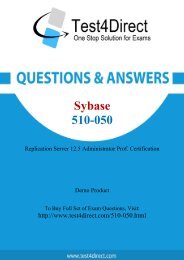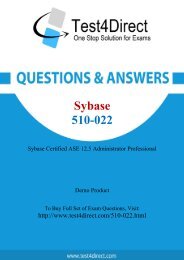312-50v8 Actual Exam BrainDumps
Test4Direct provides latest PDF questions of Eccouncil 312-50v8 exam. You have an opportunity to pass the Eccouncil 312-50v8 exam in one go. Test4Direct is most accurate source to prepare Eccouncil 312-50v8 exam as your success will become site’s responsibility after purchasing 312-50v8 exam product. There are also lots of discounts and promotion offers that you can avail. Let’s try a free demo http://www.test4direct.com/312-50v8.html
Test4Direct provides latest PDF questions of Eccouncil 312-50v8 exam. You have an opportunity to pass the Eccouncil 312-50v8 exam in one go. Test4Direct is most accurate source to prepare Eccouncil 312-50v8 exam as your success will become site’s responsibility after purchasing 312-50v8 exam product. There are also lots of discounts and promotion offers that you can avail. Let’s try a free demo http://www.test4direct.com/312-50v8.html
You also want an ePaper? Increase the reach of your titles
YUMPU automatically turns print PDFs into web optimized ePapers that Google loves.
Eccouncil<br />
<strong>312</strong>-50V8<br />
Certified Ethical Hacker v8<br />
Demo Product<br />
To Buy Full Set of <strong>Exam</strong> Questions, Visit:<br />
http://www.test4direct.com/<strong>312</strong>-50V8.html
Version: 7.3<br />
Question: 1<br />
Which of the following countermeasure can specifically protect against both the MAC Flood and MAC<br />
Spoofing attacks?<br />
A. Configure Port Security on the switch<br />
B. Configure Port Recon on the switch<br />
C. Configure Switch Mapping<br />
D. Configure Multiple Recognition on the switch<br />
Question: 2<br />
Question: 3<br />
Answer: A<br />
Jimmy, an attacker, knows that he can take advantage of poorly designed input validation routines to<br />
create or alter SQL commands to gain access to private data or execute commands in the database.<br />
What technique does Jimmy use to compromise a database?<br />
A. Jimmy can submit user input that executes an operating system command to compromise a target<br />
system<br />
B. Jimmy can gain control of system to flood the target system with requests, preventing legitimate<br />
users from gaining access<br />
C. Jimmy can utilize an incorrect configuration that leads to access with higher-than expected<br />
privilege of the database<br />
D. Jimmy can utilize this particular database threat that is an SQL injection technique to penetrate a<br />
target system<br />
Answer: D<br />
This IDS defeating technique works by splitting a datagram (or packet) into multiple fragments and<br />
the IDS will not spot the true nature of the fully assembled datagram. The datagram is not<br />
reassembled until it reaches its final destination. It would be a processor-intensive task for IDS to<br />
reassemble all fragments itself, and on a busy system the packet will slip through the IDS onto the<br />
network. What is this technique called?<br />
A. IP Routing or Packet Dropping<br />
B. IDS Spoofing or Session Assembly<br />
C. IP Fragmentation or Session Splicing<br />
D. IP Splicing or Packet Reassembly<br />
Answer: C
Question: 4<br />
If a competitor wants to cause damage to your organization, steal critical secrets, or put you out of<br />
business, they just have to find a job opening, prepare someone to pass the interview, have that<br />
person hired, and they will be in the organization.<br />
How would you prevent such type of attacks?<br />
A. It is impossible to block these attacks<br />
B. Hire the people through third-party job agencies who will vet them for you<br />
C. Conduct thorough background checks before you engage them<br />
D. Investigate their social networking profiles<br />
Question: 5<br />
Answer: C<br />
This type of Port Scanning technique splits TCP header into several packets so that the packet filters<br />
are not able to detect what the packets intends to do.<br />
A. UDP Scanning<br />
B. IP Fragment Scanning<br />
C. Inverse TCP flag scanning<br />
D. ACK flag scanning<br />
Answer: B
Question: 6<br />
Joel and her team have been going through tons of garbage, recycled paper, and other rubbish in<br />
order to find some information about the target they are attempting to penetrate. How would you<br />
call this type of activity?<br />
A. Dumpster Diving<br />
B. Scanning<br />
C. CI Gathering<br />
D. Garbage Scooping<br />
Question: 7<br />
Question: 8<br />
Answer: A<br />
Anonymizer sites access the Internet on your behalf, protecting your personal information from<br />
disclosure. An anonymizer protects all of your computer's identifying information while it surfs for<br />
you, enabling you to remain at least one step removed from the sites you visit.<br />
You can visit Web sites without allowing anyone to gather information on sites visited by you.<br />
Services that provide anonymity disable pop-up windows and cookies, and conceal visitor's IP<br />
address.<br />
These services typically use a proxy server to process each HTTP request. When the user requests a<br />
Web page by clicking a hyperlink or typing a URL into their browser, the service retrieves and displays<br />
the information using its own server. The remote server (where the requested Web page resides)<br />
receives information on the anonymous Web surfing service in place of your information.<br />
In which situations would you want to use anonymizer? (Select 3 answers)<br />
A. Increase your Web browsing bandwidth speed by using Anonymizer<br />
B. To protect your privacy and Identity on the Internet<br />
C. To bypass blocking applications that would prevent access to Web sites or parts of sites that you<br />
want to visit.<br />
D. Post negative entries in blogs without revealing your IP identity<br />
What type of attack is shown in the following diagram?<br />
Answer: B, C, D
A. Man-in-the-Middle (MiTM) Attack<br />
B. Session Hijacking Attack<br />
C. SSL Spoofing Attack<br />
D. Identity Stealing Attack<br />
Answer: A<br />
Question: 9<br />
Jack Hacker wants to break into Brown Co.'s computers and obtain their secret double fudge cookie<br />
recipe. Jack calls Jane, an accountant at Brown Co., pretending to be an administrator from Brown<br />
Co. Jack tells Jane that there has been a problem with some accounts and asks her to verify her<br />
password with him ''just to double check our records.'' Jane does not suspect anything amiss, and<br />
parts with her password. Jack can now access Brown Co.'s computers with a valid user name and<br />
password, to steal the cookie recipe. What kind of attack is being illustrated here?<br />
A. Reverse Psychology<br />
B. Reverse Engineering<br />
C. Social Engineering<br />
D. Spoofing Identity<br />
E. Faking Identity<br />
Question: 10<br />
How do you defend against ARP Spoofing? Select three.<br />
A. Use ARPWALL system and block ARP spoofing attacks<br />
B. Tune IDS Sensors to look for large amount of ARP traffic on local subnets<br />
C. Use private VLANS<br />
D. Place static ARP entries on servers, workstation and routers<br />
Question: 11<br />
Answer: C<br />
Answer: A, C, D<br />
Explanation:<br />
ARPwall is used in protecting against ARP spoofing.<br />
Incorrect answer:<br />
IDS option may works fine in case of monitoring the traffic from outside the network but not from<br />
internal hosts.<br />
TCP SYN Flood attack uses the three-way handshake mechanism.<br />
1. An attacker at system A sends a SYN packet to victim at system B.<br />
2. System B sends a SYN/ACK packet to victim A.<br />
3. As a normal three-way handshake mechanism system A should send an ACK packet to system B,<br />
however, system A does not send an ACK packet to system B. In this case client B is waiting for an
ACK packet from client A.<br />
This status of client B is called _________________<br />
A. "half-closed"<br />
B. "half open"<br />
C. "full-open"<br />
D. "xmas-open"<br />
Answer: B<br />
Question: 12<br />
Lori is a Certified Ethical Hacker as well as a Certified Hacking Forensics Investigator working as an IT<br />
security consultant. Lori has been hired on by Kiley Innovators, a large marketing firm that recently<br />
underwent a string of thefts and corporate espionage incidents. Lori is told that a rival marketing<br />
company came out with an exact duplicate product right before Kiley Innovators was about to<br />
release it. The executive team believes that an employee is leaking information to the rival company.<br />
Lori questions all employees, reviews server logs, and firewall logs; after which she finds nothing.<br />
Lori is then given permission to search through the corporate email system. She searches by email<br />
being sent to and sent from the rival marketing company.<br />
She finds one employee that appears to be sending very large email to this other marketing<br />
company, even though they should have no reason to be communicating with them. Lori tracks down<br />
the actual emails sent and upon opening them, only finds picture files attached to them. These files<br />
seem perfectly harmless, usually containing some kind of joke. Lori decides to use some special<br />
software to further examine the pictures and finds that each one had hidden text that was stored in<br />
each picture.<br />
What technique was used by the Kiley Innovators employee to send information to the rival<br />
marketing company?<br />
A. The Kiley Innovators employee used cryptography to hide the information in the emails sent<br />
B. The method used by the employee to hide the information was logical watermarking<br />
C. The employee used steganography to hide information in the picture attachments<br />
D. By using the pictures to hide information, the employee utilized picture fuzzing<br />
Question: 13<br />
Answer: C<br />
You run nmap port Scan on 10.0.0.5 and attempt to gain banner/server information from services<br />
running on ports 21, 110 and 123.<br />
Here is the output of your scan results:
Which of the following nmap command did you run?<br />
A. nmap -A -sV -p21, 110, 123 10.0.0.5<br />
B. nmap -F -sV -p21, 110, 123 10.0.0.5<br />
C. nmap -O -sV -p21, 110, 123 10.0.0.5<br />
D. nmap -T -sV -p21, 110, 123 10.0.0.5<br />
Answer: C<br />
Question: 14<br />
How do you defend against Privilege Escalation?<br />
A. Use encryption to protect sensitive data<br />
B. Restrict the interactive logon privileges<br />
C. Run services as unprivileged accounts<br />
D. Allow security settings of IE to zero or Low<br />
E. Run users and applications on the least privileges<br />
Answer: A, B, C, E<br />
Question: 15<br />
What does ICMP (type 11, code 0) denote?<br />
A. Source Quench<br />
B. Destination Unreachable<br />
C. Time Exceeded<br />
D. Unknown Type<br />
Answer: C<br />
Question: 16<br />
You are the security administrator of Jaco Banking Systems located in Boston. You are setting up e-<br />
banking website (http://www.ejacobank.com) authentication system. Instead of issuing banking<br />
customer with a single password, you give them a printed list of 100 unique passwords. Each time<br />
the customer needs to log into the e-banking system website, the customer enters the next<br />
password on the list. If someone sees them type the password using shoulder surfing, MiTM or<br />
keyloggers, then no damage is done because the password will not be accepted a second time. Once<br />
the list of 100 passwords is almost finished, the system automatically sends out a new password list<br />
by encrypted e-mail to the customer.<br />
You are confident that this security implementation will protect the customer from password abuse.<br />
Two months later, a group of hackers called "HackJihad" found a way to access the one-time<br />
password list issued to customers of Jaco Banking Systems. The hackers set up a fake website<br />
(http://www.e-jacobank.com) and used phishing attacks to direct ignorant customers to it. The fake<br />
website asked users for their e-banking username and password, and the next unused entry from<br />
their one-time password sheet. The hackers collected 200 customer's username/passwords this way.<br />
They transferred money from the customer's bank account to various offshore accounts.
Your decision of password policy implementation has cost the bank with USD 925, 000 to hackers.<br />
You immediately shut down the e-banking website while figuring out the next best security solution<br />
What effective security solution will you recommend in this case?<br />
A. Implement Biometrics based password authentication system. Record the customers face image<br />
to the authentication database<br />
B. Configure your firewall to block logon attempts of more than three wrong tries<br />
C. Enable a complex password policy of 20 characters and ask the user to change the password<br />
immediately after they logon and do not store password histories<br />
D. Implement RSA SecureID based authentication system<br />
Question: 17<br />
Question: 18<br />
Question: 19<br />
Answer: D<br />
More sophisticated IDSs look for common shellcode signatures. But even these systems can be<br />
bypassed, by using polymorphic shellcode. This is a technique common among virus writers ?it<br />
basically hides the true nature of the shellcode in different disguises.<br />
How does a polymorphic shellcode work?<br />
A. They encrypt the shellcode by XORing values over the shellcode, using loader code to decrypt the<br />
shellcode, and then executing the decrypted shellcode<br />
B. They convert the shellcode into Unicode, using loader to convert back to machine code then<br />
executing them<br />
C. They reverse the working instructions into opposite order by masking the IDS signatures<br />
D. They compress shellcode into normal instructions, uncompress the shellcode using loader code<br />
and then executing the shellcode<br />
Answer: A<br />
SYN Flood is a DOS attack in which an attacker deliberately violates the three-way handshake and<br />
opens a large number of half-open TCP connections. The signature of attack for SYN Flood contains:<br />
A. The source and destination address having the same value<br />
B. A large number of SYN packets appearing on a network without the corresponding reply packets<br />
C. The source and destination port numbers having the same value<br />
D. A large number of SYN packets appearing on a network with the corresponding reply packets<br />
Answer: B<br />
Which of the following type of scanning utilizes automated process of proactively identifying<br />
vulnerabilities of the computing systems present on a network?<br />
A. Port Scanning<br />
B. Single Scanning
C. External Scanning<br />
D. Vulnerability Scanning<br />
Answer: D<br />
Question: 20<br />
The following script shows a simple SQL injection. The script builds an SQL query by concatenating<br />
hard-coded strings together with a string entered by the user:<br />
The user is prompted to enter the name of a city on a Web form. If she enters Chicago, the query<br />
assembled by the script looks similar to the following:<br />
SELECT * FROM OrdersTable WHERE ShipCity = 'Chicago'<br />
How will you delete the OrdersTable from the database using SQL Injection?<br />
A. Chicago'; drop table OrdersTable --<br />
B. Delete table'blah'; OrdersTable --<br />
C. EXEC; SELECT * OrdersTable > DROP --<br />
D. cmdshell'; 'del c:\sql\mydb\OrdersTable' //<br />
Question: 21<br />
What are the limitations of Vulnerability scanners? (Select 2 answers)<br />
Question: 22<br />
Answer: A<br />
A. There are often better at detecting well-known vulnerabilities than more esoteric ones<br />
B. The scanning speed of their scanners are extremely high<br />
C. It is impossible for any, one scanning product to incorporate all known vulnerabilities in a timely<br />
manner<br />
D. The more vulnerabilities detected, the more tests required<br />
E. They are highly expensive and require per host scan license<br />
Answer: A, C<br />
Stephanie works as senior security analyst for a manufacturing company in Detroit. Stephanie<br />
manages network security throughout the organization. Her colleague Jason told her in confidence<br />
that he was able to see confidential corporate information posted on the external website<br />
http://www.jeansclothesman.com. He tries random URLs on the company's website and finds<br />
confidential information leaked over the web. Jason says this happened about a month ago.<br />
Stephanie visits the said URLs, but she finds nothing. She is very concerned about this, since<br />
someone should be held accountable if there was sensitive information posted on the website.<br />
Where can Stephanie go to see past versions and pages of a website?
A. She should go to the web page Samspade.org to see web pages that might no longer be on the<br />
website<br />
B. If Stephanie navigates to Search.com; she will see old versions of the company website<br />
C. Stephanie can go to Archive.org to see past versions of the company website<br />
D. AddressPast.com would have any web pages that are no longer hosted on the company's website<br />
Question: 23<br />
Question: 24<br />
Answer: C<br />
Dan is conducting penetration testing and has found a vulnerability in a Web Application which gave<br />
him the sessionID token via a cross site scripting vulnerability. Dan wants to replay this token.<br />
However, the session ID manager (on the server) checks the originating IP address as well. Dan<br />
decides to spoof his IP address in order to replay the sessionID. Why do you think Dan might not be<br />
able to get an interactive session?<br />
A. Dan cannot spoof his IP address over TCP network<br />
B. The scenario is incorrect as Dan can spoof his IP and get responses<br />
C. The server will send replies back to the spoofed IP address<br />
D. Dan can establish an interactive session only if he uses a NAT<br />
Answer: C<br />
Jason works in the sales and marketing department for a very large advertising agency located in<br />
Atlant<br />
a. Jason is working on a very important marketing campaign for his company's largest client. Before<br />
the project could be completed and implemented, a competing advertising company comes out with<br />
the exact same marketing materials and advertising, thus rendering all the work done for Jason's<br />
client unusable. Jason is questioned about this and says he has no idea how all the material ended up<br />
in the hands of a competitor.<br />
Without any proof, Jason's company cannot do anything except move on. After working on another<br />
high profile client for about a month, all the marketing and sales material again ends up in the hands<br />
of another competitor and is released to the public before Jason's company can finish the project.<br />
Once again, Jason says that he had nothing to do with it and does not know how this could have<br />
happened. Jason is given leave with pay until they can figure out what is going on.<br />
Jason's supervisor decides to go through his email and finds a number of emails that were sent to the<br />
competitors that ended up with the marketing material. The only items in the emails were attached<br />
jpg files, but nothing else. Jason's supervisor opens the picture files, but cannot find anything out of<br />
the ordinary with them.<br />
What technique has Jason most likely used?<br />
A. Stealth Rootkit Technique<br />
B. ADS Streams Technique<br />
C. Snow Hiding Technique<br />
D. Image Steganography Technique<br />
Answer: D
Question: 25<br />
What type of Virus is shown here?<br />
A. Cavity Virus<br />
B. Macro Virus<br />
C. Boot Sector Virus<br />
D. Metamorphic Virus<br />
E. Sparse Infector Virus<br />
Answer: E
THANKS FOR TRYING THE DEMO OF OUR PRODUCT<br />
Visit Our Site to Purchase the Full Set of <strong>Actual</strong> <strong>312</strong>-50V8 <strong>Exam</strong> Questions With Answers.<br />
http://www.test4direct.com/<strong>312</strong>-50V8.html<br />
We Also Provide Practice <strong>Exam</strong> Software That Simulates Real <strong>Exam</strong> Environment And Has<br />
Many Self-Assessment Features. Download Free Product Demo From:<br />
http://www.test4direct.com/<strong>312</strong>-50V8.html<br />
Money Back Guarantee<br />
Check Out Our Customer Testimonials

















